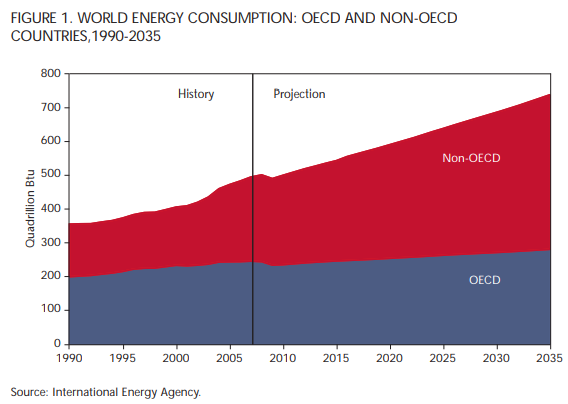
In his 2011 State of the Union Address, President Barack Obama included clean energy and clean technology among the major themes as fundamental conditions for America’s march to compete for the future. He mentioned education, science, research and innovation in the energy future of the US, including clean coal technology, in an economic agenda to create employment, drive investment and secure markets.
There is little doubt that in assessing the rush to invest in these areas by China and other developing countries, the US president is acutely aware the US must gain competitive advantage if it is to retain its position as the world’s preeminent economy. To fail to do so could have serious impacts on retaining and attracting brains, securing markets and ensuring that, contrary to what some are thinking, the US is not a declining world power.
To innovate and deliver a mixed energy portfolio and reduce its carbon footprint, while sustaining growth, is a laudable objective. Obama framed the challenge in simple but eloquent terms: “winning the future.” Innovating for clean energy is a big part of that.
Climate change may no longer be part of the conversation in Washington, but clean energy and clean technology are an important part of the policy mix.
As Obama said: “The first step in winning the future is encouraging American innovation.”
He added: “We’re issuing a challenge. We’re telling America’s scientists and engineers that if they assemble teams of the best minds in their fields, and focus on the hardest problems in clean energy, we’ll fund the Apollo projects of our time.”
Climate change may no longer be part of the conversation in Washington, but clean energy and clean technology are an important part of the policy mix.
In terms of reducing greenhouse gas emissions, the Harper government and the Obama administration are on the same page — both support the Copenhagen objective of reducing GHG emissions to 17 percent below 2005 levels by 2020. While this creates a level playing field for the integrated US and Canadian economies, the issue remains gridlocked in the US Congress, with no prospect of legislation passing any time soon.
Moreover, the US and Canada have radically different energy sources. While more than half of Canada’s electricity comes from hydroelectricity (a renewable resource), with only 10 percent coming from coal, the reverse is true in the US — more than half of the nation’s electricity is powered by coal. And as Derek Burney, a former Canadian ambassador to the US, pointed out in November 2010 in Policy Options, “The carbon imprint of coal-fired plants in the US is 64 times that of the oil sands.”
We are more sensitive to energy issues now, thanks to a decade of intense media coverage, political positioning on climate and energy issues, volatility in the price and sometimes the availability of traditional fossil fuels, and unrealistic expectations advanced by competing lobbies. They argue that if we had the courage we could simply replace dirty coal, other carbon-intensive fossil fuels and move into a world of clean, carbon-neutral energy.
Renewable energy is energy that is naturally replenished; sources include wind, sun, rain, tides, geothermal heat, biomass and biofuels. Nonrenewables, by contrast, include our traditional fossil fuels, which are formed geologically from plant and animal life over eons: these have fuelled our industrial and modern ages and are the great majority of energy and transportation fuels that underpin most economies. Reserves that are economically recoverable are also on the decline in terms of availability for fuels including oil and its derivatives, natural gas, coal and its various adapted fuels.
Let’s start with coal, which even today is the most abundant and the most widely used to generate electricity as well as to supply industries such as steel making with coking coal (the recent floods in Queensland in Australia have pinched the supply of high-quality coking coal, which our modern society takes for granted). The US Geological Survey estimates coal reserves in the US to be 475 billion tonnes. At today’s demand rate this is enough coal to meet the demand for another 200 years. Petroleum reserves are already in decline, while natural gas reserves may be more plentiful. New sources, however, are deeper in our earth’s crust and more expensive to extract. Shale gas, for example, is plentiful, but requires different technologies and rigorous standards to minimize environmental risks.
Fossil fuels are prominent today, and they will be with us for decades, even as we move toward cleaner energy sources and learn to more efficiently use the energy and fuels available to us. Energy efficiency has made and can make what we generate go farther, serve more people and last longer while reducing carbon footprints. Savings from new technology (smart grids and soon) can make a 15 to 30 percent difference, and this will be our best low-hanging fruit over the next two decades. It is necessary, but not sufficient, in light of expected world energy demand.
The coal industry has invested massively in trying to develop “clean coal technology” to remove the health consequences of impurities from coal. A process that turns coal into synthetic gas prior to combustion has, along with better scrubber technology, brought about real improvements. The same applies to the oil industry (including the oil sands), where carbon capture and storage (CCS) capabilities are being developed and research has reduced the intensity of carbon per barrel of oil.
The issue is not just what has been and is being done, but the increasing appetites of consumers here and in a greatly expanding developed world for more and more energy. According to the US Department of Energy, the world’s total energy demand today is 400 quadrillion British thermal units
(BTUs). A BTU is roughly equivalent to the energy and light generated by a match. It may sound inconsequential, but the volume of BTUs is enormous and expected to increase to meet growing economic needs, not to mention the increase in the world’s population from some 6 billion to 9 billion people in the coming decades. Of this global demand, oil, coal and natural gas supply close to 90 percent, while nuclear power supplies 3 percent. Oil’s share is 41 percent, while coal’s share is 24 percent and natural gas accounts for 22 percent.
By comparison, renewable energy collectively provides 7 percent of the world’s needs. However, between 2004 and 2009, capacity in renewable sources grew at 10 to 16 percent annually. During 2009 more wind power was added than any other source of renewable energy. Platt’s December 2010 report draws an interesting picture of developments in various regions across a spectrum of energy sources with a focus on both opportunities and challenges, as economies attempt to position themselves in a new world in energy.
In 2011, experts forecast that wind-generated power will add 40 gigawatts (GW) of capacity, bringing the world’s generation to 200 GW, with a doubling to 400 GW by 2014. The solar industry is also expanding, with corresponding manufacturing for solar photovoltaics breaking the gigawatt barrier in the third quarter of 2010 for the first time ever. Ernst and Young’s 2010 report on investment in this sector has China in first place in terms of investing in energy innovation and renewable energy, outpacing the US. Canada stands at number 9 in the top 10, with the US, European states and India taking the 2nd to 8th positions (table 1). This should be a wake-up call in today’s post-financialcrisis world — a call that has not yet resonated with enough people and legislators in the OECD economies.
There are important issues in considering energy, not least reliability of the supply and energy security. We tend to ignore in our discussions the critical value and wealth generation role that energy plays in our daily lives and our future well-being. Canada is more fortunate here than other countries. For example, we are sitting on 170 billion barrels of proven oil reserves, second largest in the world after Saudi Arabia.
In this country the oil and gas industries contributed some $19 billion to government revenues in 2009. Revenues from federal, provincial and territorial income taxes on the sector amounted to $7.5 billion (2005 figures). Together the provincial governments collect an additional $8 billion per year from excise taxes on energy-related products. Hydro-Québec’s dividend to the Quebec government in 2009 alone was $2.17 billion. This is not to mention all the jobs in the energy industry, and the economic multipliers they generate.
Energy companies invest additional billions in permits, machinery, construction and capacity expansions, thereby creating additional jobs. Over a 10-year period in Quebec, public investments in new generation capacity, including renewable energy, will amount to some $25 billion. None of this is without controversy. We are a country that consumes huge amounts of energy, which we require to be delivered reliably and as cheaply as possible. We want more renewables and more fuel switching, but we want them out of sight and certainly not close enough to create noise or visibly ruin pristine landscapes. We do not automatically draw the link between the value-creating and wealth-generating facets of being energy rich and the standard of life, social programs and benefits we enjoy as a modern society.
We want the revenues from supplying energy to the US markets, provided we are similarly not bothered by more transmission lines for hydroelectricity or pipelines for natural gas. The chills set in whenever we think that others might gain a carbon advantage by consuming our cleaner Canadian-sourced power or fuels. In fact, our surpluses of even conventional fossil fuels provide an
energy security advantage for our US neighbours, from which Canada benefits. We should keep in mind that at the pace technology is moving, this might not last forever, even if our reserves are likely to be in demand for decades.
The reason this is a dilemma is our desire to resolve the pollution and GHG emissions that come from the extraction and combustion of fossil fuels. Oil, coal and natural gas companies share this concern and are themselves investing in renewable energy. More than most, they realize that one day we are going to run out of conventional fuels and that we are in a long-term transition to very different forms of energy in the future, some of them yet to be invented. This is at the heart of Obama’s challenge to “win the future” through innovation.
This takes us to future scenarios in which the basic winning condition is reliable, secure, environmentally responsible energy and fuels to meet the growing demands of both our economies and our growing populations. This is why China and others are investing massively in alternative energy technologies, innovation and research in order to secure their energy and economic futures.
The International Energy Agency (IEA) World Energy Outlook (2010) is a reminder of what we are likely to face and how important energy literacy will be for us all. The world’s primary energy demand will increase by 36 percent, or 1.2 percent per year, by 2035 (figure 1). This does not sound like much, until you consider that in the previous 27 years the increase was only 2 percent.
Non-OECD countries will account for 93 percent of this projected increase; China alone will account for 36 percent of it. China, in addition to surpassing the US in investments in renewable energy, also passed the US as the world’s largest energy user in 2009.
According to the IEA, oil will remain the dominant fuel in the energy mix to 2035: nuclear will increase by 2 percent, while the total share from renewable sources will increase from 7 to 14 percent of world demand. Natural gas is expected to resume its upward trajectory, increasing by 44 percent due to its more attractive environmental attributes. Unconventional oils and gas (shale), “regardless of what governments do to curb demand,” will grow from 3 percent today to 10 percent of world demand. The IEA goes on to say that “the rate at which unconventional resources are exploited will be determined by economic considerations and the costs of mitigating their environmental impacts.”
These are some of the realities we ignore at our own peril — the world’s population is forecast to grow to 9 billion by 2050 and the energy needed to meet this increase will be proportionate. All forms of renewable energy are likely to increase, either for power generation or for transport, heat and light.
The corresponding need to reduce our carbon footprint and greenhouse gas emissions will require government leadership, as well as public investments to accompany private sector money, so that we can double technological rates of change, testing and commercializing new sources of energy. This pickup in pace is unprecedented in the postwar period.
In the words of the Union of Concerned Scientists, “No single simple solution can meet our society’s future energy needs. The solution instead will come from a family of diverse energy technologies that share a common thread — they do not deplete our natural resources or destroy our environment.”
The Winnipeg Consensus Group, comprising the Energy Policy Institute of Canada (EPIC) as well as 11 Canadian research institutes and think-tanks, including the IRPP, came to the conclusion that Canada needs leadership from its governments to synergize the potential that geography and nature have given us in abundance. According to EPIC, a Canadian strategy would, in recognition of our constitutional and jurisdictional powers, be “firmly tied to social and developmental goals.” Such a strategy would allow Canada and its trading partners to “look to green technologies and integrated energy systems as a means to drive economic renewal while achieving environmental goals.”
We require governmental collaboration and federal government leadership to achieve our collective ambition to be an energy superpower and meet the demands of an interdependent carbon-constrained world. We have the brains and we have the tools. The question is, do we have the political will? What better ambition for a country like ours than to move on the axis of energy, environment and the economy in order to continue to enjoy sustainable prosperity?
Photo: Shutterstock








